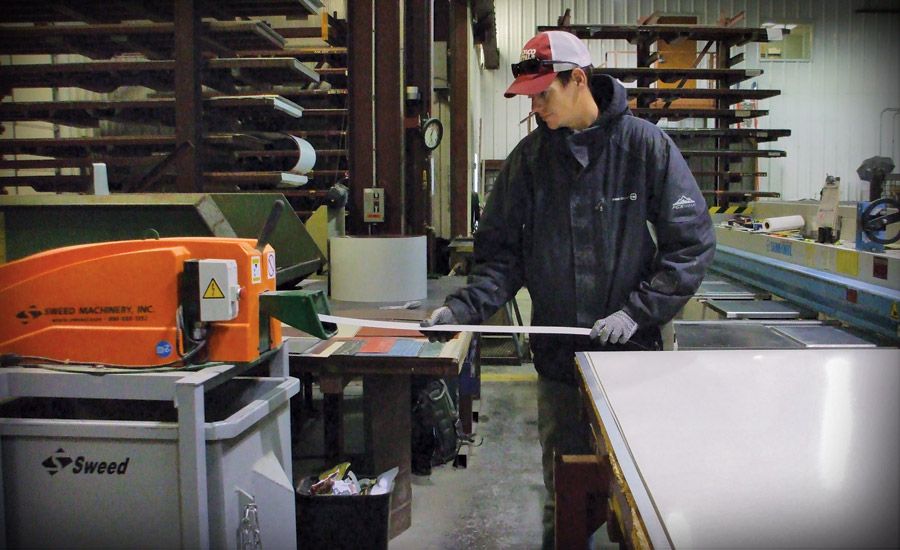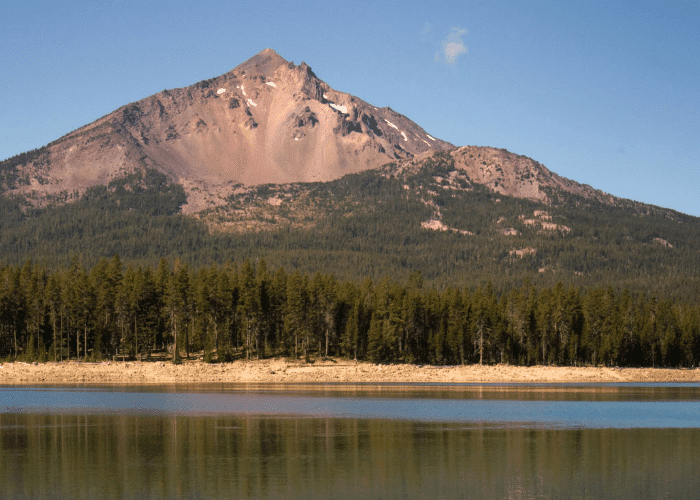Scrap chopper improves slitter line efficiency and safety
Written By: Kenneth A. Hooker for Modern Metals Magazine

Chop, Chop
Indaco Metals Inc. set out last fall to find a better way to handle and dispose of its steel scrap. Based in Shawnee, Okla., the company produces sheet steel wall panels, standing-seam metal roofing panels and trim components used in its pre-engineered and custom metal buildings.
At the time, scrap from Indaco’s trim and slitter lines was being collected, folded and stuffed by hand into bins for recycling. The process was messy, slow and potentially hazardous. It also made inefficient use of space in the recycling bins. The recent acquisition of a scrap chopper from Sweed Machinery Inc. has gone a long way toward solving those problems.
A family-owned business, Indaco Metals was established in 1995. Its original 6,000-square-foot facility has since grown to encompass more than 42,000 square feet of manufacturing, office and warehouse space. Its product line includes truss- and rigid-framed metal buildings, roofing, carports and patio covers.
Plant manager Allen Krausse describes the operation. “Indaco Metals is [like] a lumberyard for metal building products, including a full line of support items. We sell directly to the public, as well as to contractors and architects. We roll-form coils of sheet metal into panels for building roofs and sidewalls. Each panel is formed as one of three types: Duraloc or R-Panels (36-inch girth) or standing-seam roofing panels (15-inch girth), all cut to the length prescribed by the customer.
“We have an engineering group that engineers custom structures as well as pre-engineered building packages. We also have a weld shop that fabricates the building frames. We utilize plate steel or formed steel to build tapered beams, as prescribed by our engineering group. We further have our own transportation group that delivers materials to job sites,” Krausse says.
Scrap Generation
Two processes in the Indaco plant generate most of the scrap destined for recycling. Some of the scrap is produced in the trim shop, where 26-gauge sheet metal is sheared to length to make trim pieces for the metal building components. Most of the rest is produced on the slitter line, where rolls of sheet metal are slit and then recoiled for roll forming the standing seam roofing products. Drop from the edges of these rolls is typically about an inch to an inch and a half wide. It doesn’t recoil well and was always difficult to process manually. Krausse says the slitter line scrap would “wind up on the floor in a mess.”
Workers in the trim shop and on the slitter line had to pick up the scrap, fold it and place it in scrap bins. The material was unwieldy and sharp, so people handling it risked cuts to their hands and faces. Furthermore, Krausse says, the folded scrap took up a lot of bin space.

A Fitting Solution
Indaco Metals CEO Josh Inda asked Krausse to research whether a scrap chopper could improve the efficiency of the operation. The company ultimately chose a Scrap Chopper Model 450 SL from Sweed Machinery. The chopper accepts continuous lengths of scrap which it then cuts into pieces about 3 inches long for efficient recycling. Modified to meet Indaco Metal’s needs, the unit is designed to work within a system that continuously produces linear scrap as a byproduct.
The operator feeds the scrap into the machine’s funnel. Pinch rolls inside the chopper grab the material and pull it into the path of a rotating knife, which chops it into small pieces and drops the chopped scrap into a self-dumping hopper positioned underneath. The feedworks continues to match the production line speed without requiring a controlling line signal until either all the material is consumed or the operator releases the feedworks by pulling the release lever.
The chopper is compact—about 40 inches by 25 inches by 19 inches—and weighs 355 pounds. Power is supplied by a 1 horsepower electric motor. The blades are configured so they can be rotated four times for extended service life.
“The folks at Sweed were very helpful in ensuring we’d have a unit that would meet our need. It was custom fit to meet our requirements. The Sweed engineers asked us what gauge and width of scrap we wanted to process, as well as what feed rate we needed for our process. We ended up purchasing all three components: the chopper itself, a rolling support stand and a 3⁄4-cubic-yard dumping hopper to collect the chopped scrap. The hopper holds about 2,000 pounds of product. The components fit nicely together, were reasonably priced and save space,” Krausse says.
“We placed the unit near the end of the recoiling station to collect and chop drop from the slitting process. We only needed to adjust the clutch to match the flow of material feeding into the unit. Since it’s portable, though, we can easily move it to the trim shop to chop the scrap there. And we can move the hopper with a forklift and dump scrap into the recycling container,” he says.
Finding a Match
One of the engineers charged with helping Sweed Machinery customers find the right machine is Eric V. Schmidt. He explains the process this way: “There are all kinds of factors to consider in determining the best chopper for an application, including the type of material, the required cut length, the rate of processing, the available space, and more. Our process for choosing the best chopper and custom components to handle the job begins with a Design Selection Sheet. This form is completed by the customer and helps Sweed engineers understand the customer’s specific needs and requirements. Our engineering and sales staff work closely with the customer from the beginning of the design phase through the manufacturing of the end product to achieve total customer satisfaction.”
Based in Gold Hill, Ore., Sweed Machinery has been building and selling scrap choppers to all types of industries since the 1950s. Many of the original machines sold are still in operation today, says Schmidt. “We have a wide range of standard scrap choppers to fit many applications including steel and plastic banding, but we also do a large volume of engineered-to-order solutions, like our slitter trim and tube and pipe scrap choppers. About half of the choppers we sell are stock units, and the other half, like Indaco’s machine, involve some custom engineering,” he says. Schmidt believes that having sales, engineering and manufacturing functions under one roof sets Sweed apart from its competitors and helps engender its customers’ trust and satisfaction.
Indaco’s Krausse represents one of those satisfied customers. “We had the machine up and running just a few days after it was delivered,” he says. “All we had to do was adjust the clutch to match the flow of material coming in, and that was easy because the unit came with good instructions.” Krausse also shares this comment from Indaco’s maintenance supervisor, “This has been one of the few items we have purchased that did what it was advertised to do out of the box.” Working closely with a vendor to choose the right piece of equipment paid off.
Kenneth A. Hooker is a freelance writer based in Oak Park, Ill.

